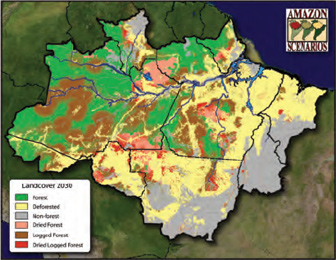Amazon deforestation could be eliminated with carbon priced at $3
Amazon deforestation could be eliminated with carbon priced at $3
Rhett Butler, mongabay.com
December 4, 2007
Study finds that more than 90 percent of the opportunity costs of Amazon forest conservation could be compensated for a per-ton carbon value of $3. Simply eliminating deforestation would cost about $1.2 per ton of carbon.
The Amazon rainforest could play a major part in reducing greenhouse gas emissions that result from deforestation, reports a new study published by scientists at the Woods Hole Research Center, the Instituto de Pesquisa Ambiental da Amazônia, and the Universidade Federal de Minas Gerais. At a carbon price of $3 per ton, protecting the Amazon for its carbon value could outweigh the opportunity costs of forgoing logging, cattle ranching, and soy expansion in the region. 2008 certified emission-reduction credits for carbon currently trade at more than $90 per ton ($25 per ton of CO2).
The report, published as more than 10,000 policymakers and scientists meet for UN climate talks on the Indonesian island of Bali, presents a conceptual framework for estimating the costs to tropical nations of implementing programs to reduce emissions by reducing deforestation (REDD). During the 1990s, tropical deforestation and forest degradation contributed 7 to 28% of global, human-induced carbon emissions to the atmosphere. Cutting deforestation would reduce these emissions as well as provide other ecosystem services.

The Brazilian Amazon in 2030, showing drought-damaged, logged, and cleared forests. This map assumes that deforestation rates of 1997-2003 continue into the future, and that the climatic conditions of the last 10 years are repeated into the future. From Soares-Filho et al. 2006, Nepstad et al. 2004, 2007, Nepstad and Stickler in press, Merry et al. in review. See Supplemental Online Material for description of methods at http://whrc.org/Brazilcarbonsupplement. |
The report, titled “The Costs and Benefits of Reducing Carbon Emissions from Deforestation and Forest Degradation in the Brazilian Amazon,” uses Brazil as a case study for REDD. Brazil is home to the bulk of the world’s remaining tropical forest cover but has had the world’s highest average annual loss of forest for more than three decades. Nevertheless, Brazil’s forests contain more carbon (38-56 billion tons in the Amazon alone) in tropical forest trees than any other country.
The study argues that reducing deforestation in the Brazilian Amazon to zero over a ten year period from a current average of 20,000 square kilometers per year is not only acheivable at a low cost ($8 in direct government outlays and $18 billion in forgone opportunity costs over 30 years), but would bring benefits to a wide range of Brazilians, including some of the country’s poorest people–forest dwellers–who would see their income double. The initiative would also reduce fire-based costs to society (respiratory illness, deaths, agricultural and forestry damages) of $10 to $80 million per year, protect the rainfall system that fuels the Brazilian grain belt and hydroelectric energy generation, and conserve the Amazon’s unmatched biodiversity. Importantly the effort would reduce carbon emissions 6 billion tons below the historical baseline and 13 billion tons below projected levels.
Daniel Nepstad (2007). The Costs and Benefits of Reducing Carbon Emissions from Deforestation and Forest Degradation in the Brazilian Amazon [PDF]. The Woods Hole Research Center. United Nations Framework Convention on Climate Change (UNFCCC) Conference of the Parties (COP), Thirteenth session. 3-14 December 2007
Related
Could the carbon market save the Amazon rainforest?
(11/29/2007) The global carbon market could play a key role in saving the Amazon from the effects of climate change and economic development, which could otherwise trigger dramatic ecological changes, reports a new paper published in Science. The authors argue that a well-articulated plan, financed by carbon markets, could prevent the worst outcomes for the Amazon forest while generating economic benefits for the region’s inhabitants.
Is the Amazon more valuable for carbon offsets than cattle or soy?
(10/17/2007) After a steep drop in deforestation rates since 2004, widespread fires in the Brazilian Amazon (September and October 2007) suggest that forest clearing may increase this year. All told, since 2000 Brazil has lost more than 60,000 square miles (150,000 square kilometers) of rainforest — an area larger than the state of Georgia or the country of Bangladesh. Most of this destruction has been driven by clearing for cattle pasture and agriculture, often in association with infrastructure development and improvements. Higher commodity prices, especially for beef and soy, have further spurred forest conversion in the region. While drivers of Amazon deforestation are stronger than ever, mounting concerns over climate change and the effort to reign in greenhouse gas emissions may provide new economic incentives for landowners to preserve forest lands through a concept known as “avoided deforestation”.














